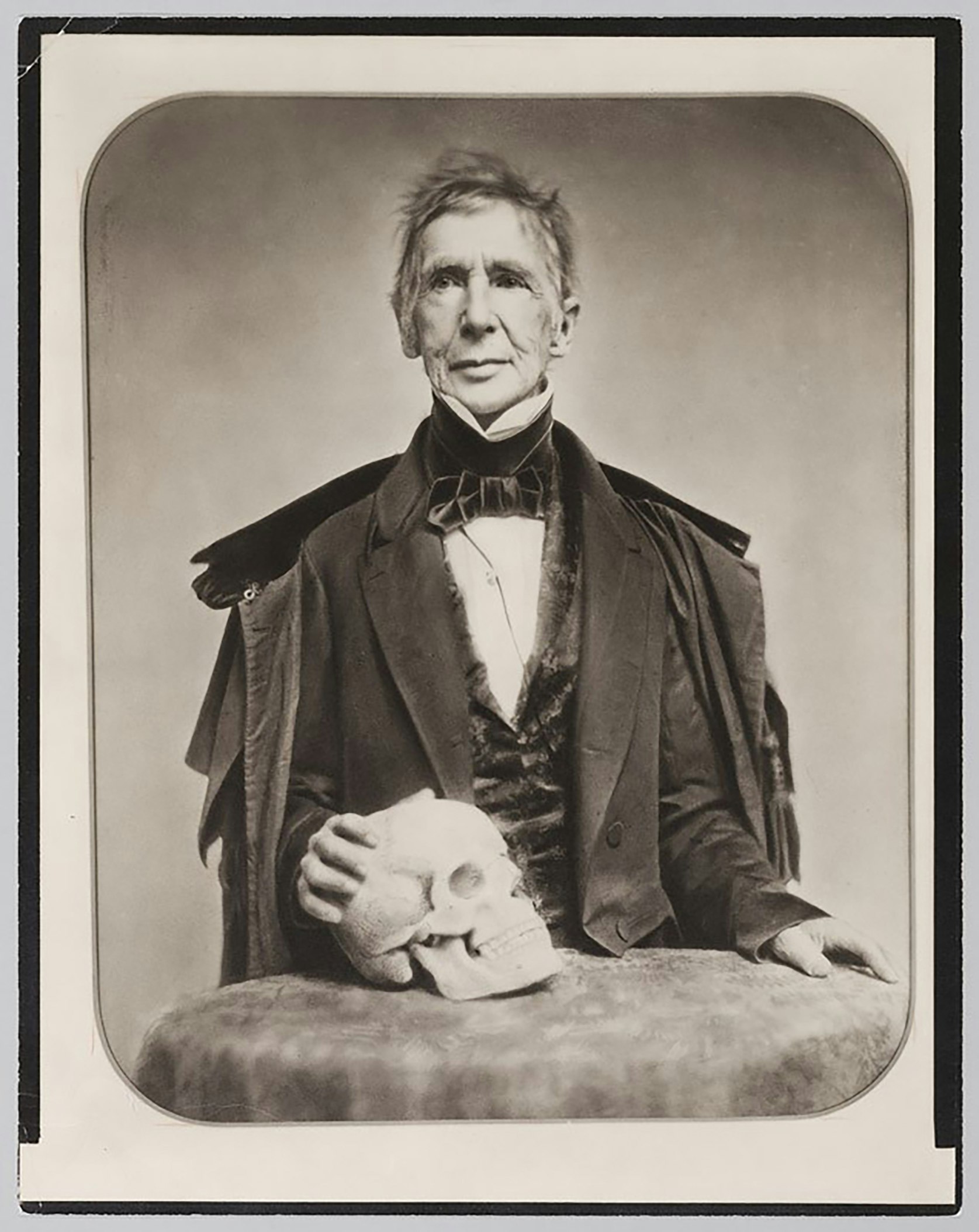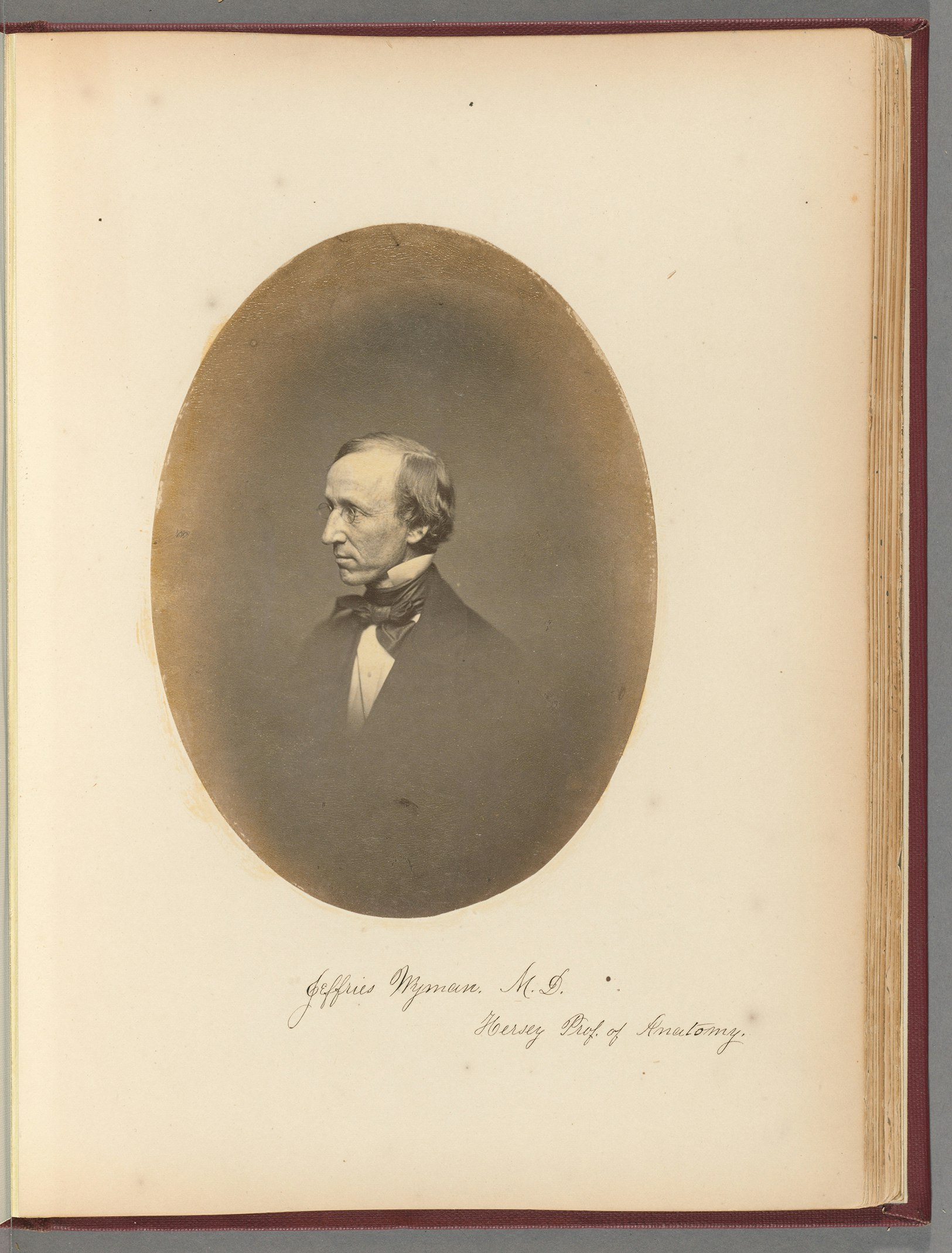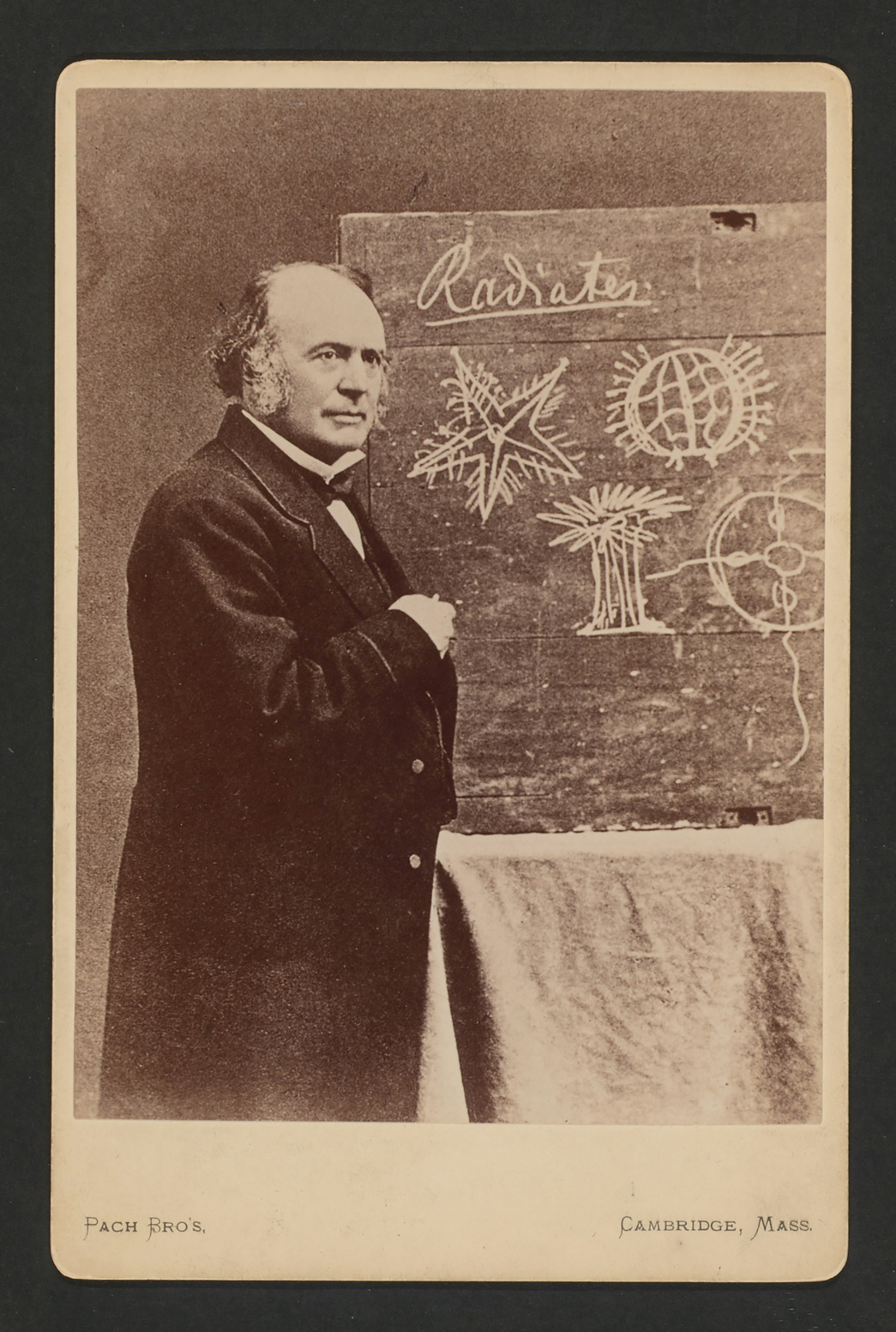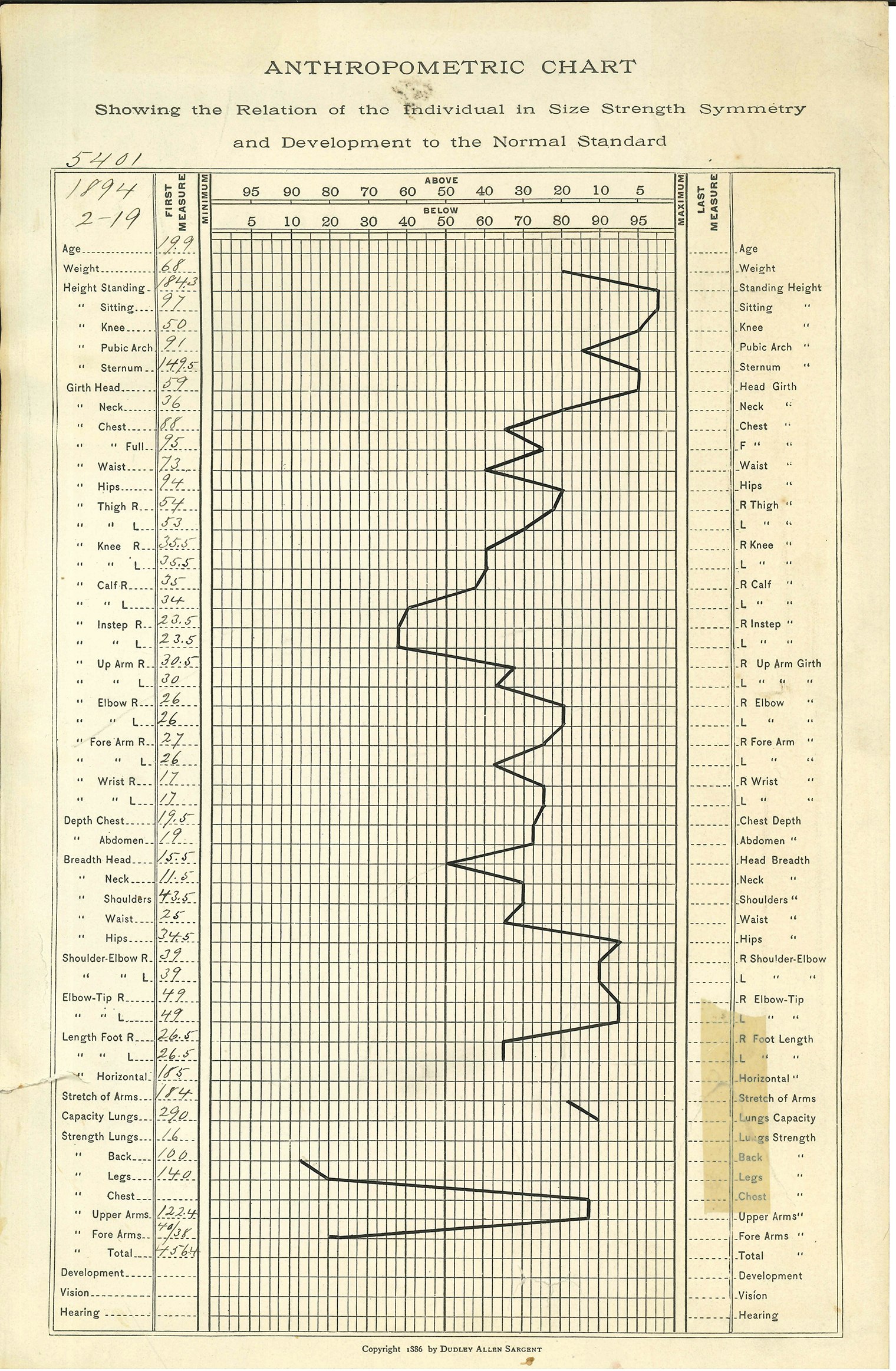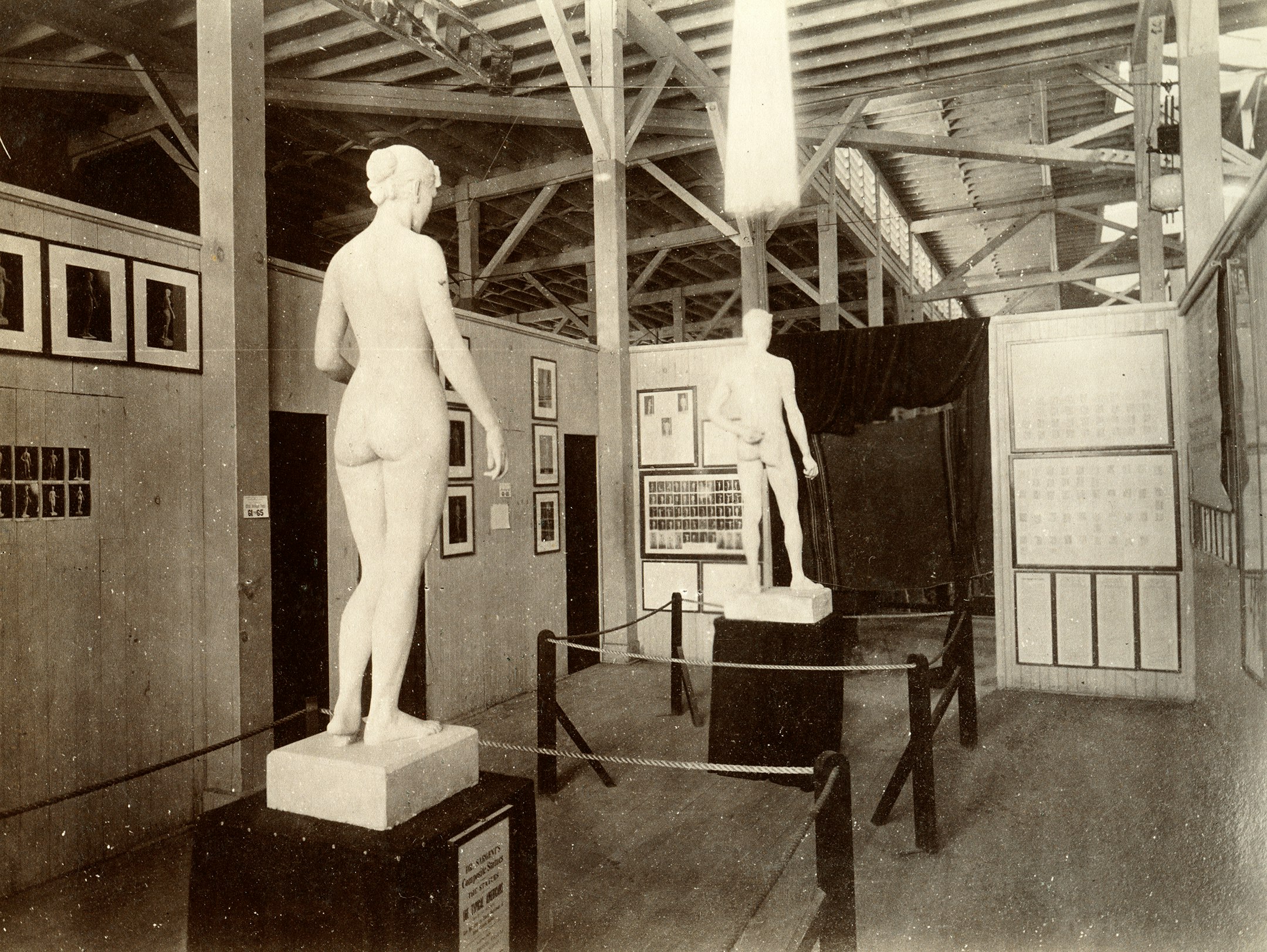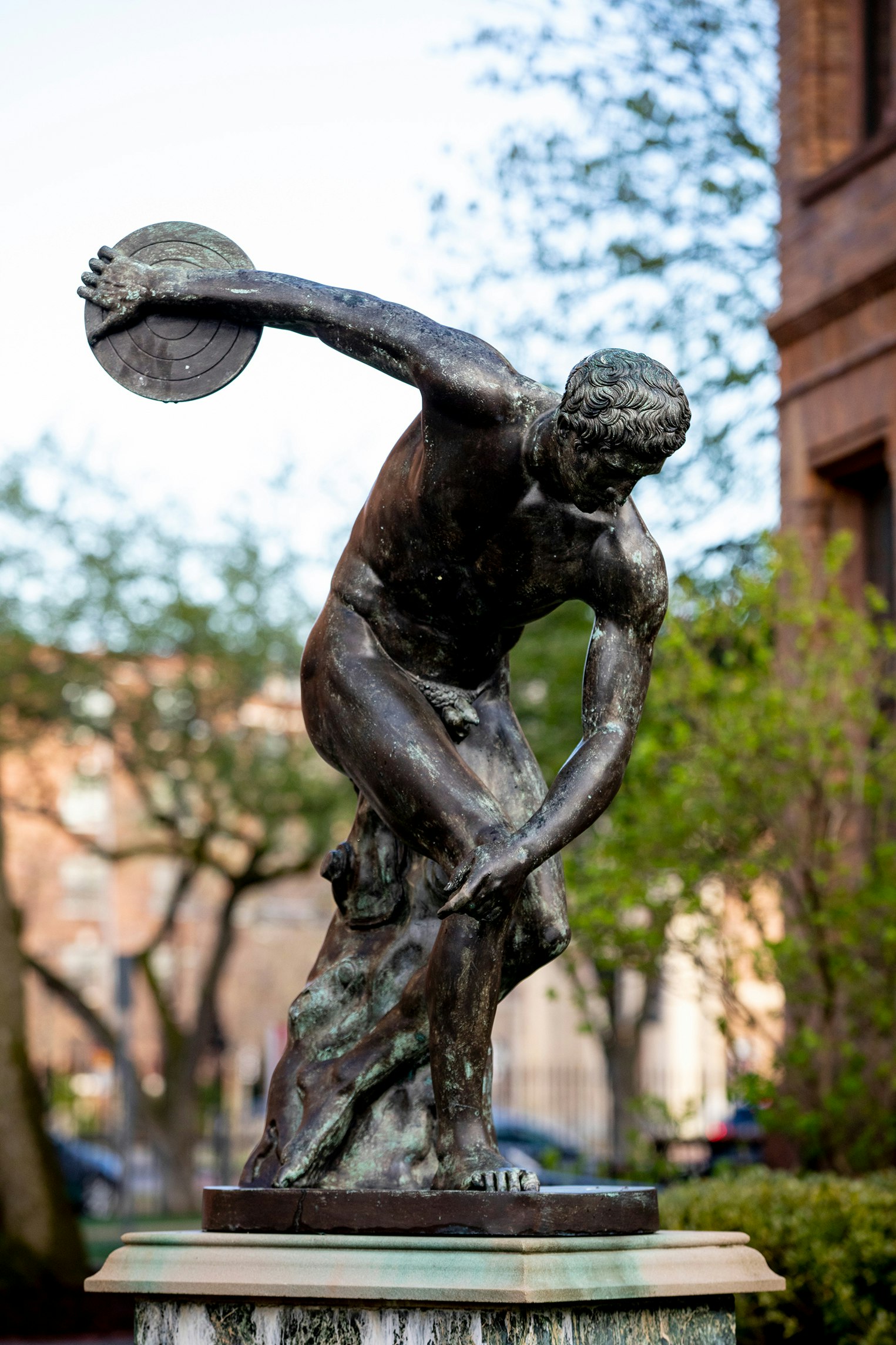Legacies of Slavery in Scholarship: Race Science
By 1850, Harvard Medical School had become a focal point of scientific theories and practices rooted in racial hierarchy, racial exclusion, and discrimination at the University. That same year, as we have seen, the passage of the Fugitive Slave Act of 1850, requiring the return of enslaved people to their owners even if slaves had escaped to free states, turned more white Northerners against slavery and its cruelties. Yet support for antislavery efforts remained anemic at Harvard, even amid the rise of abolitionist sentiment in the Commonwealth. Indeed, at Harvard Medical School, the forces of conformity with the racial status quo, aided by Harvard presidents and leading Harvard faculty members, prevailed against those who dissented.
Harvard Medical School Dean Oliver Wendell Holmes Sr. was at the helm during an 1850 controversy over the abortive admission of the Medical School’s first three Black students, and his views on race help contextualize this episode.Go to footnote 740 detail They also shed light on the group of hugely influential Harvard faculty members whose work in so-called “race science”—the study of racial differences that emphasized the superiority of whites and inferiority of African peoples—would legitimize racist views among generations of scientists, medical researchers, and indeed political leaders. An alumnus of Harvard College (1829) and Harvard Medical School (1836), Holmes was a prominent anatomist and a prolific poet when he became dean in 1847.Go to footnote 380 detail Among his friends and colleagues were the race science proponents Jeffries Wyman and Louis Agassiz, also hired in 1847 as the University worked to grow its ranks of prominent scientists in the 19th century.Go to footnote 381 detail Holmes, like many scientists of the time, held similar views to Wyman and Agassiz. Holmes at times promoted the idea of innate differences in moral character, health, and intelligence among races.Go to footnote 382 detail He also defined “the Brahmin caste of New England” to describe himself and his peers, distinguishing between “the common country-boy, whose race has been bred to bodily labor” and the “races of scholars,” like himself, who “take to [their] books as a pointer or a setter to his field-work.”Go to footnote 383 detail In an Atlantic Monthly essay published in April 1875, Holmes cited, among others, Francis Galton, an English scientist known as the father of eugenics,Go to footnote 384 detail asserting that “in most cases, crime can be shown to run in the blood.”Go to footnote 385 detail
Such ideas were perhaps related to Holmes’s engagement with anatomical racial difference.Go to footnote 386 detail During the 19th century, Harvard had begun to amass human anatomical specimens, some of which were the bodies of enslaved people. Holmes was among the scientists who donated human remains to the Warren Anatomical Museum, including a skull (apparently from Africa): “The obliteration of the cranial sutures that characterize the African is finely shown,” he explained.Go to footnote 387 detail Such racialized collections would, in the hands of the University’s prominent medical and scientific authorities, become central to the promotion of race science at Harvard and many American institutions, as discussed in greater detail below.
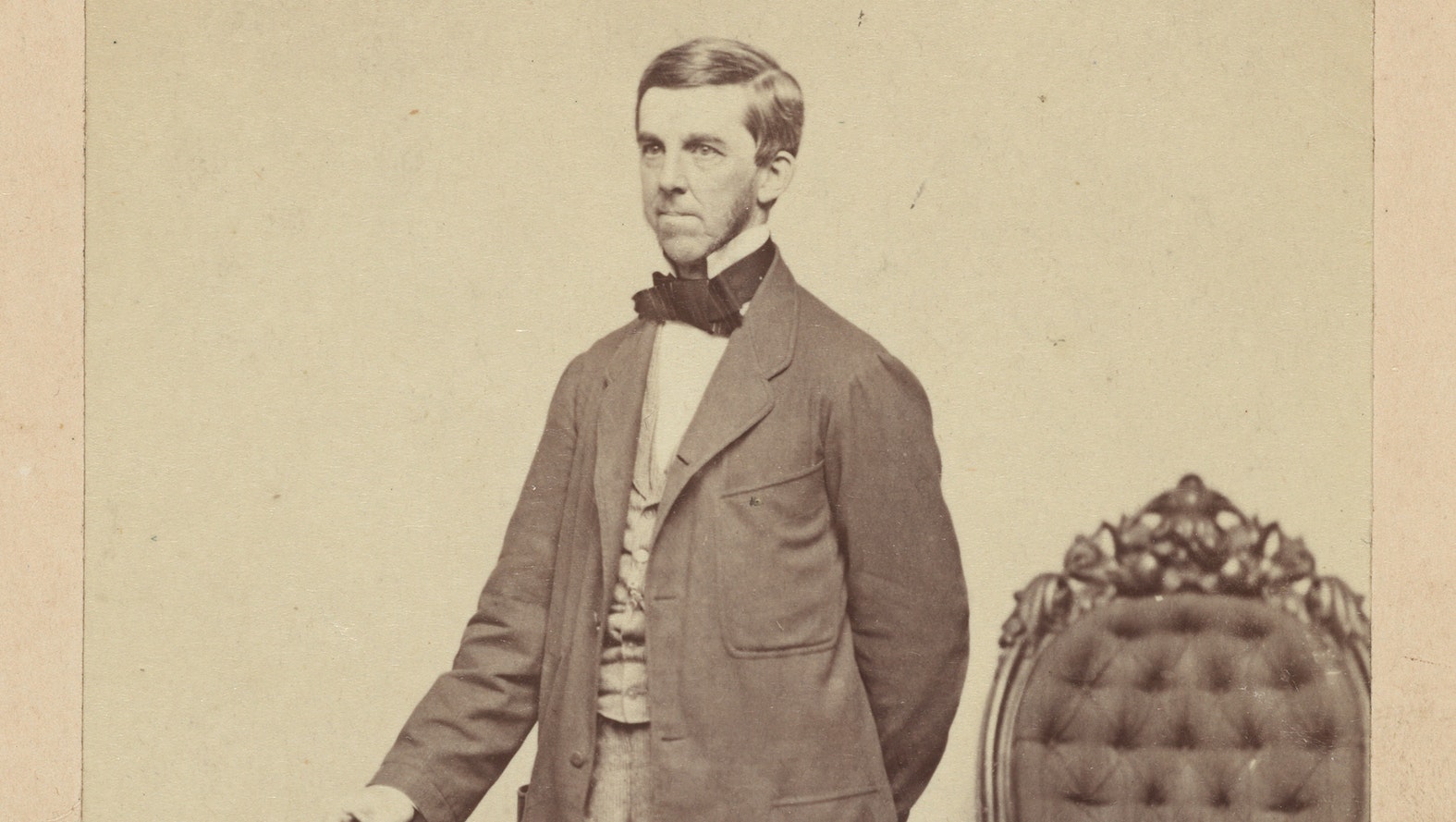
Oliver Wendell Holmes Sr. and Black Students at Harvard Medical School
On November 2, 1850, Holmes met with Medical School faculty members to consider an inquiry about the admission of two Black students, Daniel Laing Jr. and Isaac H. Snowden, who were well qualified and had the support of members of the American Colonization Society (ACS), which advocated for the removal of free Black Americans to Africa.Go to footnote 388 detail The day before, Abraham R. Thompson and Joseph Tracy, the former a Medical School alumnus (1826) and both members of the ACS Board of Directors, had written to the Medical School faculty endorsing Laing and Snowden as “two young men of colour, pursuing medical studies … for the purpose of practicing in the Republic of Liberia in Africa, where their services are greatly needed.”Go to footnote 389 detail The faculty voted to admit.Go to footnote 390 detail
Not long thereafter, a third Black applicant sought admission on his own initiative. Martin Robison Delany, who was already a prominent abolitionist, writer, and speaker, visited Dean Holmes in person. Although Delany was not supported by the ACS like Laing and Snowden, he too had the prerequisite medical training, and 17 white doctors from Allegheny County, Pennsylvania, had endorsed his application. Holmes extended an offer of admission.Go to footnote 391 detail

Laing, Snowden, and Delany would, however, have a tumultuous and extremely brief tenure at the Medical School. Their reversal of fortune started when 10 white students signed a petition asking to be “informed whether colored persons [were] to be admitted as students at another course of lectures.”Go to footnote 392 detail Other resolutions followed. On December 10, 1850, some 60 of Laing, Snowden, and Delany’s 116 white colleagues met and, by a slim majority, voted to endorse a resolution stating that the admission of Black students would degrade the quality of their degrees. The signers refused to “be identified as fellow-students, with blacks; whose company we would not keep in the streets, and whose society as associates we would not tolerate in our houses.”Go to footnote 393 detail
The opposition to the Black students was not universal. Another group of students drafted a competing resolution on December 11, cautioning the University against rescinding admission to the three Black students: “As students of science … they would feel it a far greater evil, if, in the present state of public feeling, a medical college in Boston could refuse to this unfortunate class any privileges of education, which it is in the power of the profession to bestow.”Go to footnote 394 detail
Nevertheless, Holmes and the faculty determined to exclude the three Black students, deeming them irritants and distractions to the educational environment. In a letter to the sponsors of Laing and Snowden, Holmes and the faculty described this episode as a failed “experiment,” which had proved that “the intermixing of different races, on a footing of equality and personal proximity during the course of Lectures, is distasteful to a large portion of the class, and injurious to the interests of the School.”Go to footnote 395 detail
Race Scientists: Louis Agassiz, John Collins Warren, and Jeffries Wyman
This episode took place in the context of the growth of race science at Harvard, which provided an intellectual framework to justify the exclusion and marginalization of Blacks that would endure into the 20th century. Along with Holmes, those engaging with racial difference at Harvard included John Collins Warren (AB 1797; dean, 1816–1819; faculty, 1809–1856), the son of one of the Medical School’s cofounders and himself the first dean of the faculty of medicine, and Holmes’s contemporaries Jeffries Wyman (faculty, 1838–1840 and 1847–1874) and Louis Agassiz (hon. 1848; faculty, 1847–1873). No one was as influential in this area as the renowned Swiss-born scientist Agassiz, yet each of these men—Warren, Wyman, and Agassiz—left powerful legacies on Harvard’s campus and in the wider world.
Agassiz and Wyman both joined Harvard at a time of institution-building, Agassiz at the new Lawrence Scientific School and Wyman, like Holmes, at the Medical School.Go to footnote 396 detail Wyman succeeded Warren as a professor of anatomy, but Warren remained active in the University until his death in 1856. These three men, as colleagues and collaborators, were instrumental in the creation of major Harvard institutions.
The Warren Anatomical Museum, now housed within Harvard Medical School’s Countway Library, was established when Warren donated his and his father’s vast collections of “pathological and other specimens” to Harvard, including human skulls and “phrenological” casts.Go to footnote 397 detail Wyman led the creation of the Peabody Museum of Archaeology and Ethnology, where he served as inaugural curator. And Agassiz established and served as the first curator of the Museum of Comparative Zoology.Go to footnote 398 detail
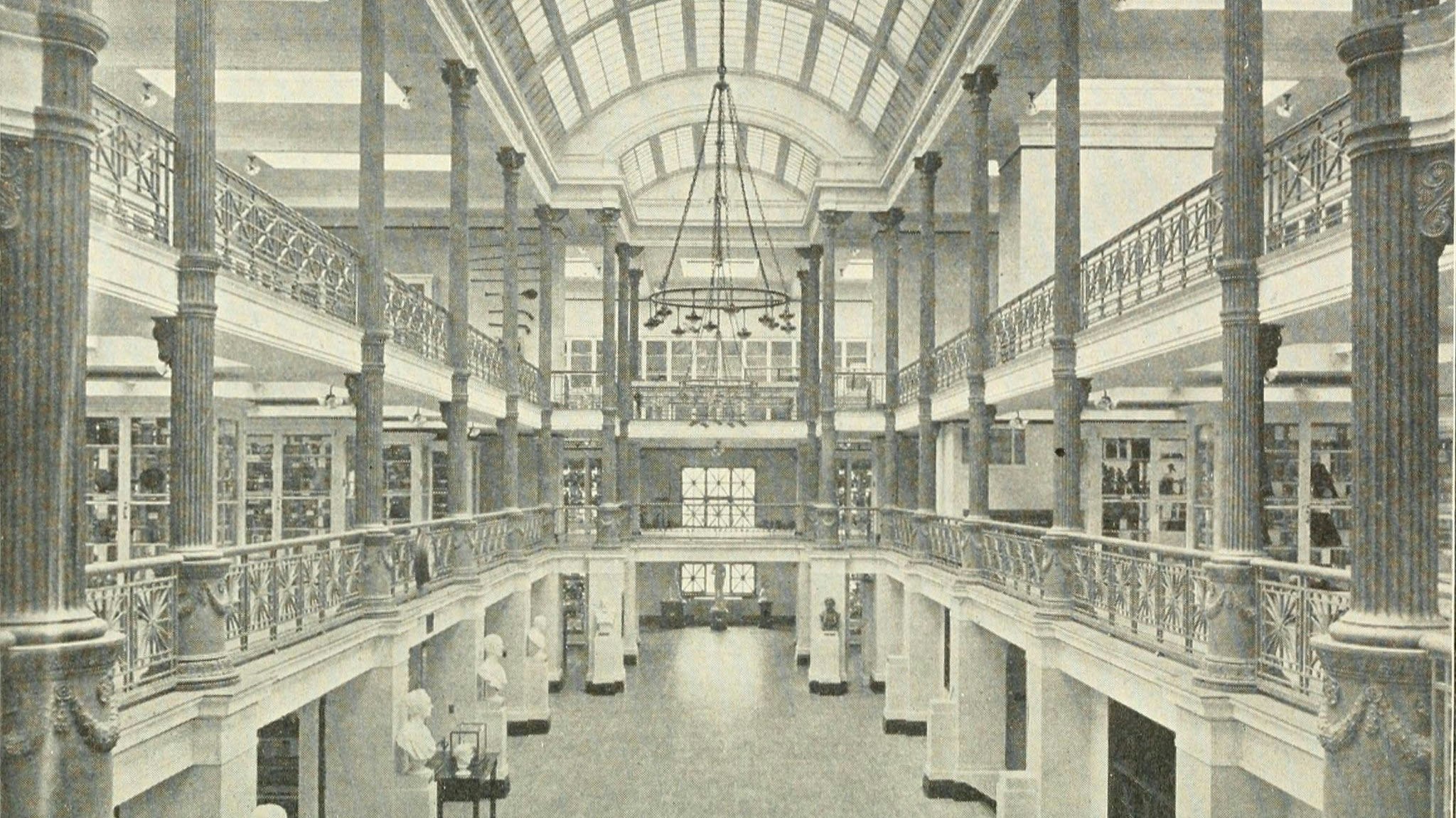
The Agassiz name remains visible across Harvard’s campus and the City of Cambridge. Louis, who served as professor of zoology and geology from 1847 to 1873 and as curator of the Museum of Comparative Zoology from its founding in 1862 until 1873,Go to footnote 399 detail is the most well-known member of the Agassiz family. Yet the memorials that remain are generally named for his wife, Elizabeth Cary Agassiz (for instance a professorship, a gate in Radcliffe Yard, and Elizabeth Cary Agassiz House, home of the Harvard College Admissions Visitor Center), or for his son, Alexander Agassiz (namesake of Harvard professorships).
Elizabeth is credited as coauthor of A Journey in Brazil (1868), a travelogue about their yearlong scientific expedition in the country, discussed below.Go to footnote 400 detail She also left her own powerful mark at Harvard: in 1879, she was among a group of reformers who founded the Harvard Annex, where women could receive instruction from Harvard faculty. The Annex was soon incorporated as the Society for the Collegiate Instruction of Women, and in 1894, it was chartered as Radcliffe College. Elizabeth served as the first president of Radcliffe College and was a pioneering leader in the history of women’s education.Go to footnote 401 detail Alexander, an engineer and investor in copper mining as well as a scholar of natural history, also worked closely with his father. He handled much of Louis’s correspondence in the final years of his life and succeeded Louis as curator of the Museum of Comparative Zoology in 1874.Go to footnote 402 detail Alexander donated substantial sums to several organizations in the final years of his life, including more than $200,000 to the museum to support research, publications, and the professorships that still bear his name.Go to footnote 403 detail
Agassiz’s Early Career and the Zealy Daguerreotypes
Louis Agassiz’s journey to Harvard began when he was invited to deliver the Lowell Institute’s Lowell Lectures.Go to footnote 404 detail While the institute was not affiliated with Harvard, it was a forum that attracted many esteemed Harvard affiliates as lecturers and guests. Agassiz’s 1845 invitation came on the recommendation of the German naturalist Alexander von Humboldt, who was able to secure funding for Agassiz’s Atlantic crossing through his position as an advisor to the king of Prussia.Go to footnote 405 detail Agassiz was by then a prominent naturalist, known in Europe’s scientific circles for his work on glaciation and the classification of ancient fish species.Go to footnote 406 detail In this work, he was part of a movement toward classifying flora and fauna according to geographic origin, building upon Carl Linnaeus’s universal system of classification.Go to footnote 407 detail Naturalists of the era were known for their splendid depictions of nature and often went on scientific expeditions in the Americas to collect specimens for their research. Their preoccupation with nature also extended to the classification of humans “into a single natural hierarchy of difference and similarity,” organized under the rubric of race.Go to footnote 408 detail
The field of anthropology emerged in this context to study diversity among human groups as a function of visible racial difference.Go to footnote 409 detail Medical scientists contributed to the field’s growth by investigating relationships among racial typology, geography, and disease. Phrenology, which related the shape and size of the cranium to intellectual and moral faculties, became a popular racial scientific field; craniometry, the measurement and dissection of human skulls, was its primary method. By the 19th century, race science had become a global enterprise,Go to footnote 410 detail and Agassiz was fully immersed when he arrived in the United States in the fall of 1846.
Among the first things Agassiz did in America was to view the prominent anatomist Samuel George Morton’s skull collection in Philadelphia,Go to footnote 411 detail an early stop on his tour of the scientific community in the United States, which warmly embraced him.Go to footnote 412 detail Agassiz spent “four hours in contemplation” of the skulls of Native Americans and received a personal copy of Morton’s Crania Americana, inscribed by the author. In a letter to his mother, Agassiz wrote that Morton’s “collection alone merits a trip to the United States.”Go to footnote 413 detail He also reflected on his first encounter with African Americans:Go to footnote 414 detail “It is impossible for me to repress the feeling that they are not the same blood as us.”Go to footnote 415 detail
At this time, the United States was on the verge of establishing its own scientific institutions and schools of thought independent from those of Europe. Polygenism—which proposed not only a hierarchy of races but also separate creations of different races—was “an important agent in this transformation” because it was “of largely American origin” yet acquired authority from European scientists who had long pursued scientific theories of racial difference themselves.Go to footnote 416 detail Agassiz understood the importance of this moment in the nation’s intellectual life and saw an opportunity. Some two years later, now a member of the Harvard faculty and building a celebrity status matched by few other scientists, he declared to the Boston Society of Natural History that American scientists “had been obliged to look up to Europe as our leader and guide in this pursuit,” but “a short period of persevering labor … would place America in the position hitherto occupied by the Old World.”Go to footnote 417 detail
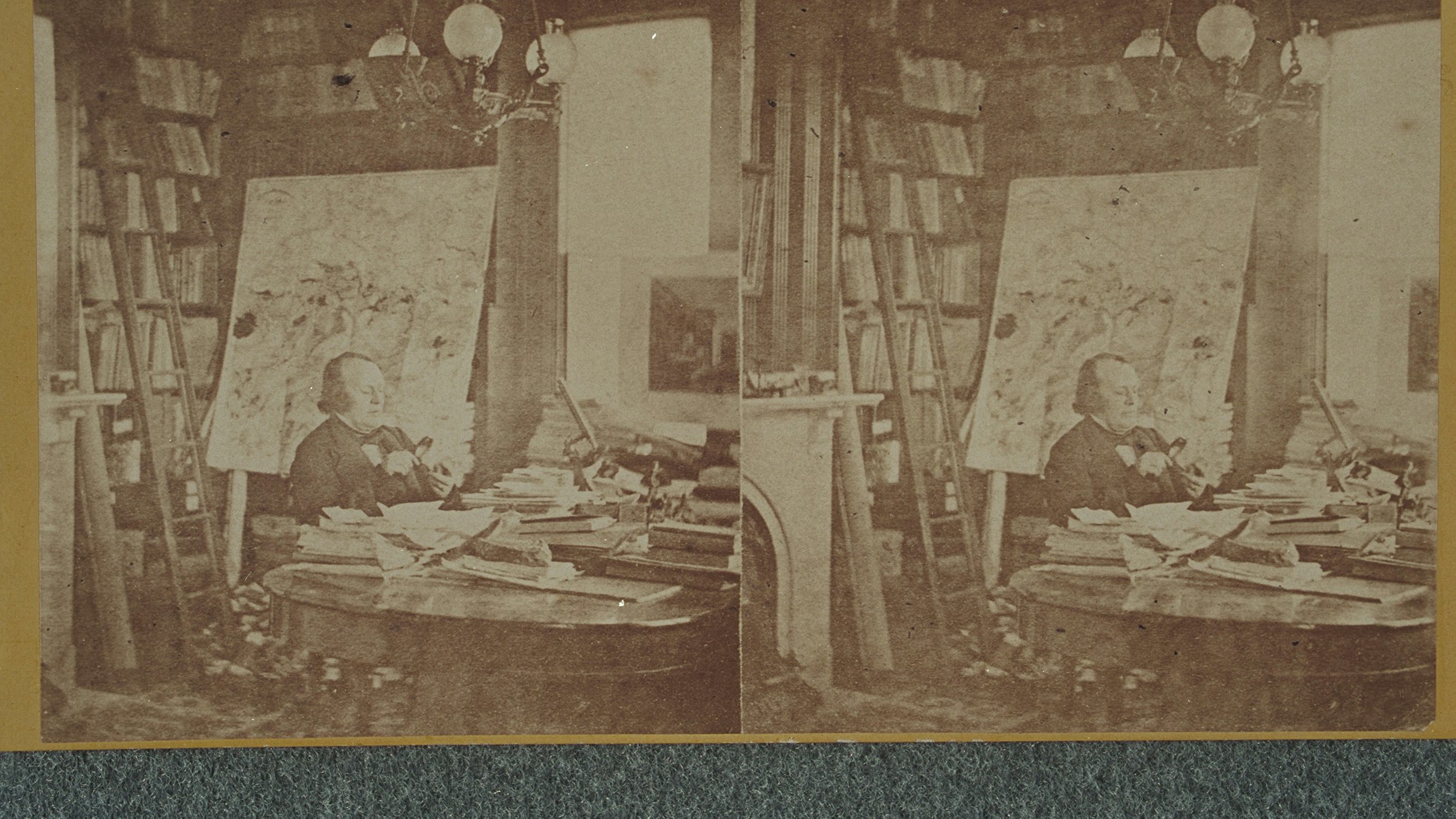
Agassiz first formally articulated his embrace of polygenism at an 1850 meeting of the American Association for the Advancement of Science (AAAS) in Charleston, South Carolina.Go to footnote 418 detail In an essay published soon thereafter, he set out to disprove the “prevailing opinion, which ascribes to all living beings upon earth one common centre of origin, from which it is supposed they, in the course of time, spread over wider and wider areas, till they finally came into their present distribution.”Go to footnote 419 detail His primary objective was “to show that there is no such statement in the book of Genesis: that this doctrine … is of very modern invention, and that it can be traced back for scarcely more than a century in the records of our science.”Go to footnote 420 detail In another essay, he concluded that Blacks were at the bottom of a racial hierarchy ordained in nature and contended that “there has never been a regulated society of black men developed” in Africa, suggesting a “peculiar apathy … to the advantages afforded by civilized society.”Go to footnote 421 detail
Such views were controversial even then. The first half of the 19th century represented a period of hardening of race as a scientific concept in the United States, at the height of debate over “monogenesis” versus “polygenesis,” or the single versus separate origins of races.Go to footnote 422 detail Monogenists, who believed in a single human creation, immediately criticized Agassiz’s arguments. Writing to her then fiancé, Elizabeth Cary noted the opposition building to his ideas: “Some of the Church people are out upon you in the papers, for your disrespect of Adam as the common father of mankind.”Go to footnote 423 detail Congress was also, at this time, debating the Fugitive Slave Act, the passage of which would galvanize antislavery sentiment in New England.Go to footnote 424 detail Agassiz flatly denied that his research had bearing on the fraught political question of slavery,Go to footnote 425 detail although he asserted that it was “mock-philanthropy and mock-philosophy to assume that all races have the same abilities, enjoy the same powers, and show the same natural dispositions, and that in consequence of this equality they are entitled to the same position in human society.”Go to footnote 426 detail
Agassiz was celebrated in the South, where he was invited to the homes of prominent slaveholders and gave iterations of his 1850 AAAS lecture.Go to footnote 427 detail Some of these visits were arranged by a local paleontologist and physician who welcomed Agassiz to plantations in Columbia, South Carolina, to examine enslaved Africans as live research specimens. Following Agassiz’s examination, Joseph T. Zealy made daguerreotype images of seven men and women for Agassiz’s further study: Delia, Jack, Renty, Drana, Jem, Alfred, and Fassena.Go to footnote 428 detail In so doing, Zealy created what the New York Times described in 2020 as “some of history’s cruelest, most contentious images—the first photographs, it is believed, of enslaved human beings.”Go to footnote 429 detail
It was more than a century before historians retraced the identities and origins of the individuals represented in Agassiz’s daguerreotypes. We now know that Delia, Renty’s daughter, was an enslaved girl from Columbia, and that Jack was Drana’s father. Fassena, noted in the daguerreotype as a carpenter, was Mandingo, originally from modern southern Mali and Northern Guinea. They are each pictured nude or nearly so.Go to footnote 430 detail
Agassiz returned to the South in 1851–1852 with his new wife, Elizabeth, who would become his frequent collaborator. The collection of research specimens—including human specimens—remained his focus.Go to footnote 431 detail In an 1852 letter, he begged pardon for his delayed arrival at his next destination, explaining that he “found … an excellent opportunity of examining the negros, of which I must avail myself.”Go to footnote 432 detail
Agassiz’s wide-ranging specimen collections were a celebrated part of life and learning at Harvard. In an 1850 report to the overseers, University President Jared Sparks highlighted Agassiz’s, Wyman’s, and the University’s collections. Some of these were on display in Holden Chapel, used by the Medical School as a lecture hall and then assigned to the new Lawrence Scientific School, including a “curious collection of casts of skulls … which was purchased and presented to the University several years ago.”Go to footnote 433 detail
Wyman, Agassiz, and Sturmann
In September of 1860, “an extraordinary importation from South Africa” arrived in Boston—five human beings described as “a Fuigo, a Zulu, a Kaffir, a Bushman, and a Hottentot, all sons of the forests and the desert who have hitherto lived the life of savages.”Go to footnote 434 detail These living “specimens,” had been acquired by the owners of the Boston Aquarial and Zoological Gardens for public exhibition. The announcement promised a one-of-a-kind experience, “seeing these specimens of human nature in a savage condition just as they appear in their native forests and wilds”—including “monkey tricks.” Their names were given as Machiado, Macormo, Macuolo, Quaggu, and Sturmann.Go to footnote 435 detail
Advertisements described how the museum space was divided into two departments: the aquarial and the zoological.Go to footnote 436 detail The Africans were to be displayed alongside an assortment of “rare and beautiful animals and birds” including seals, kangaroos, and “Serpents.”Go to footnote 437 detail “[R]efined and intellectual” ticketholders were promised performances of savagery on a regular schedule:
They will appear through the day, CLAD IN THEIR NATIVE DRESSES OF SKINS, ORNAMENTED WITH BEADS, FEATHERS AND PORCUPINE QUILLS, and every evening will go through the WAR, LOVE and FESTIVE DANCES,—(armed with their SPEARS, CLUBS, SHELLS, AND OTHER WEAPONS OF WAR AND OF THE CHASE,) and will also SING the NATIONAL SONGS of their SEVERAL TRIBES.Go to footnote 438 detail

The museum’s owners created a scholarly veneer by commissioning a detailed pamphlet purporting to describe “the early life of each individual specimen of the nomadic tribes.”Go to footnote 439 detail And Agassiz lent his scientific authority to the proceedings, addressing an inaugural gala on October 4, 1860.Go to footnote 440 detail
Three months later, when the popular showman P. T. Barnum exhibited the Africans in New York City, public outcry over the questionable nature of their “importation” prompted him to print a statement from Agassiz in local newspapers. Agassiz “testified” that they were not enslaved but “were shipped with the knowledge and consent of the local authorities,” and that “nothing was done in securing them that would be objectionable either in a moral point of view or with reference to the laws of nations.”Go to footnote 441 detail He did not identify these “local authorities,” nor did he address the consent of Machiado, Macormo, Macuolo, Quaggu, and Sturmann themselves.
One of the five, Sturmann, took his own life on April 28, 1861, after more than six months on display.Go to footnote 442 detail The Boston Evening Transcript announced his death in a brief editorial:
The young Hottentot at the Aquarial Gardens, yesterday terminated his life by hanging. He was seventeen years of age and used to drive a wagon at Port Natal. For several days he was noticed to act strangely, and, just before the commission of the fatal act, conveyed from the room, where he and his four companions domesticated, nearly every moveable article, in accordance with the practice of all suicides among his people. The other Africans at the Gardens are deeply affected by the death of their companion.Go to footnote 443 detail
Regardless of their distress, Machiado, Macormo, Macuolo, and Quaggu were “again on exhibition” on April 30.Go to footnote 444 detail
Sturmann’s time as an object of study in the service of race science was only beginning: Wyman, who had met Sturmann while he was on display, dissected the teenager’s body at Harvard, ultimately publishing his observations in an 1865 issue of the journal the Anthropological Review.Go to footnote 445 detail He took extensive measurements and compared them to those of a chimpanzee, a gorilla, and two Europeans. In a protracted discussion of Sturmann’s pelvis, he noted that in some respects it came “nearer to that of the anthropoids [apes] than of the Caucasians”Go to footnote 446 detail but concluded it “belonged to the human family.”Go to footnote 447 detail
Ultimately, Sturmann’s remains were recorded in the catalog of the Warren Anatomical Museum:
Item # 3237 cast of the head of a native Hottentot. The boy was seventeen years old, had been on exhibition for several months in this city; and finally hung himself. His skeleton is in the Museum of Comparative Zoology, at Cambridge, 1861.Go to footnote 448 detail
The casts of Sturmann’s head remain in Harvard’s collections.
Global Collecting and the Brazil Expedition
Over nearly three decades, Agassiz also engaged colleagues across the United States and around the world, especially in the Caribbean and Latin America, to collect and classify the natural world for what would become the Museum of Comparative Zoology.Go to footnote 449 detail He instructed his collectors—including patrons, friends, readers, and lecture audiences—to send him animals of all kinds from across New England, the United States, and the world.Go to footnote 450 detail His aim was to endow the United States with a museum that would rival the best collections in Europe. Agassiz initially acquired and stored most of the collection at his own cost, raising funds to support the effort from private donors, including Elizabeth Cary Agassiz’s connections among the Boston elite.Go to footnote 451 detail
The search for specimens motivated Agassiz to organize his expedition to Brazil in 1865, in the midst of the Civil War. Polygenist ideas were losing favor following the publication of Charles Darwin’s On the Origin of Species in 1859, and Agassiz identified Brazil as a prime location to continue his research and defend his claims.Go to footnote 452 detail In April 1865, with the support of a Boston financier,Go to footnote 453 detail Agassiz left for Brazil accompanied by Elizabeth and several Harvard students—including William James,Go to footnote 454 detail who would become an influential Harvard psychologist. Meanwhile Alexander Agassiz, now a naturalist in his own right and directly involved in his father’s work, assumed responsibility for the museum and handled Louis’s correspondence, including discussions of the procurement of human remains from South America.Go to footnote 455 detail
Because of the country’s racial diversity and its significant mixed-race population, Brazil had particular significance for Agassiz and other natural scientists of the 19th century.Go to footnote 456 detail In fact, race scientists had long identified Brazil as the embodiment of the dangers of race mixture, which they argued had produced a population that doomed the nation to backwardness.Go to footnote 457 detail Race mixture was Agassiz’s focus when he commissioned a new set of photographs of Brazilian enslaved and free people. Agassiz personally oversaw the production of these images, which were taken by a local photographer and a Harvard student assistant.Go to footnote 458 detail The photographs likely were staged in the courtyard of the house in Brazil where Louis and Elizabeth had at one point resided with the research crew.Go to footnote 459 detail

Louis and Elizabeth cowrote A Journey in Brazil, published in 1868, which documented the expedition and presented their findings to a general audience in the travel narrative genre of the time. In the book’s preface, Louis specifically acknowledged the important role his wife played in the endeavor:
Partly for the entertainment of her friends, partly with the idea that I might make some use of it in knitting together the scientific reports of my journey by a thread of narrative, Mrs. Agassiz began this diary. I soon fell into the habit of giving her daily the more general results of my scientific observations, knowing that she would allow nothing to be lost which was worth preserving.Go to footnote 460 detail
Elizabeth’s own correspondence confirms her deep involvement in writing and editing the manuscript.Go to footnote 461 detail Given this, it is interesting to note that the book remains silent about the Brazil photographs, even as it provides detailed depictions of other episodes, including Louis’s sketch of their house maid. Elizabeth is also thought to have expunged from other publications Louis’s most flagrantly racist views.Go to footnote 462 detail
It is unclear whether the omission of the photographs reflects Elizabeth’s discomfort with Louis’s production of the images, all nude or seminude, her effort to safeguard Louis’s reputation, or some other motivation. Whatever the reason, these omissions underscore Elizabeth’s active participation in the expedition and publication. It is also evident from her work on A Journey in Brazil that she accepted prevailing racial hierarchies and stereotypes. For example, one passage in the book describes a gathering of enslaved people that Elizabeth and the crew witnessed while Louis was elsewhere:
The dance and the song had, like the amusements of the negroes in all lands, an endless monotonous repetition. Looking at their half-naked figures and unintelligent faces, the question arose, so constantly suggested when we come in contact with this race, “What will they do with this great gift of freedom?” The only corrective for the half doubt is to consider the whites side by side with them: whatever one may think of the condition of slavery for the blacks, there can be no question as to its evil effects on their masters.Go to footnote 463 detail
Charles William Eliot: A Paradoxical Racial Legacy
Charles William Eliot, Harvard’s longest-serving president, in office for the four decades from 1869 to 1909, was an influential national figure. According to one historian, “by the turn of the century … his opinion and support were sought on every variety of public question.”Go to footnote 466 detail He and his presidential administration represent a paradox: Harvard began admitting small numbers of Black students during his presidency; at the same time, Eliot himself and prominent Harvard faculty members promoted eugenics and endorsed racial segregation.
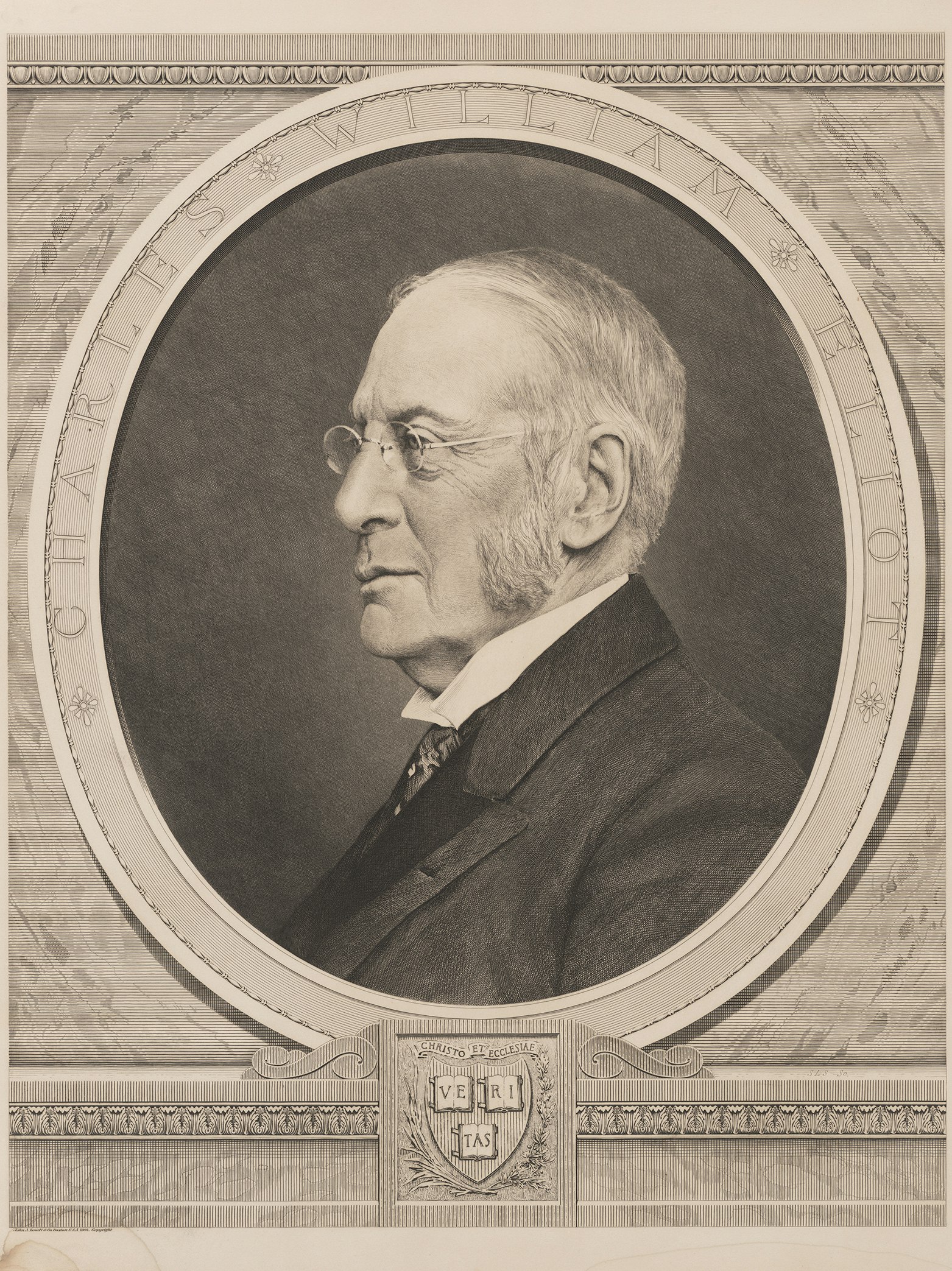
Perhaps the most significant development occurred soon after Eliot became president, and it revealed the paradox at the heart of limited Black advancement at Harvard during his presidency. In 1896, Harvard awarded an honorary degree to a Black man for the very first time: Eliot bestowed the honor upon Booker T. Washington,Go to footnote 470 detail a man who had been born in slavery and who had made a mark as an author and as the principal of the Tuskegee Institute (later the Tuskegee College and today Tuskegee University).Go to footnote 471 detail By awarding Washington an honorary degree, Harvard expressed esteem for a Black man of great ability, and that was no small thing. But that was not all the award to Washington signified: it was a politically significant choice that gave Harvard’s imprimatur to a man who achieved fame by urging Blacks to accommodate rather than fight racial exclusion, discrimination, and segregation.
Just months before Harvard honored him, Washington had gained national renown through his “Atlanta Compromise” address. In this 1895 speech, made to an audience of white Southerners during a time of rising white violence, political backlash, and legalized discrimination against descendants of slavery, Washington argued that Blacks should not agitate for racial equality or challenge segregation. “In all things that are purely social we can be as separate as the fingers, yet one as the hand in all things essential to mutual progress,” he said.Go to footnote 472 detail Instead of pursuing the “extremest folly” of social equality, Blacks should pursue vocational education and work hard in the South, including manual labor in cotton mills.Go to footnote 473 detail Washington’s proposal amounted to a “conservative social Darwinist proposition,” according to one biographer, and it delighted whites who were eager to leave the race question behind and let Blacks fend for themselves. Washington’s “compromise” enraged Black leaders bent on fighting racial inequality.Go to footnote 474 detail (In 1903, the Harvard graduate W. E. B. Du Bois would famously critique Washington’s views in The Souls of Black Folk.Go to footnote 475 detail)

It was in this context—Washington’s endorsement of Black political quiescence—that Eliot personally awarded the honorary degree to him (and 12 others) during a June 24, 1896, ceremony in Sanders Theatre. Eliot praised Washington’s remarks that evening at an alumni dinner, in which Washington—a self-described “humble representative” of the Black South—commended the “strong,” “wealthy,” and “learned” of Harvard and exhorted them to help the “ignorant” and “weak” masses rise to the “American standard.”Go to footnote 476 detail
But Harvard did relatively little to help Blacks rise during Eliot’s long presidency. Instead, Eliot himself, and Harvard’s leadership more broadly, continued to advance ideas premised on biological racial difference—the same ideas deployed to support racial segregation. Eliot supported faculty who pursued eugenics, the selective breeding of human beings premised on racial hierarchy, and after his presidency would become a prominent public advocate for the field.Go to footnote 477 detail His views were “well within the intellectual mainstream” at Harvard and throughout the country at the time,Go to footnote 478 detail and coexisted with his enthusiasm for applied science as a means to identify new solutions for long-standing social ills. These interests were not merely academic; Eliot’s views were also bound up with his politics—including his endorsement of segregation, opposition to interracial marriage, and support for eugenic sterilization—and shaped his administration of the University.
The Bussey Institution, founded in 1871 as an undergraduate department in agriculture with the proceeds of Boston merchant Benjamin Bussey’s bequest to the University,Go to footnote 479 detail was reestablished under Eliot as a graduate school of applied biology.Go to footnote 480 detail Eliot supported the new school and its faculty, clearing the way for the geneticist William E. Castle’s research into “what principles underlie the improvement of breeds” and his hereditary experiments on small mammals.Go to footnote 481 detail Castle and his ties to the global eugenicist movement are discussed in greater detail below.
Another beneficiary of Eliot’s support was Dudley Allen Sargent, assistant professor of physical training (1879–1889) and director of Hemenway Gymnasium (1879–1919).Go to footnote 482 detail As head of Hemenway, Sargent established a system of rigorous physical exercises through which students might reform their bodies into the archetypal healthy, civilized man. He also, as described by Eliot, subjected “all students who desired to take part in athletic sports or severe physical exercises” to “thorough physical examination.”Go to footnote 483 detail These intrusive physical examinations and his approach to physical education were motivated by his interest in “race improvement.”Go to footnote 484 detail
Student athletes subject to Sargent’s anthropometric evaluation began with a genealogical and family health form, which included parents’ and grandparents’ nationalities and parents’ occupations, as well as a question about which parent the students believed they “most resemble[d].” After completing the form, the students’ physical proportions were measured and plotted in a detailed chart that showed “relation, in size, strength, symmetry, and development, to the normal standard of your age and sex.”Go to footnote 485 detail As part of these examinations, Sargent took nude photographs of many students, among them a young W. E. B. Du Bois.Go to footnote 486 detail He also measured and photographed students at Radcliffe and other colleges and universities, as well as men and women at gymnasiums and community organizations, such as YMCAs and YWCAs, and at major public events, including the 1893 World’s Fair in Chicago.Go to footnote 487 detail
Sargent used his data to establish normative and idealized measurements for both sexes and commissioned drawings and sculptures to illustrate these findings.Go to footnote 488 detail Like other prominent eugenicists of the period, he was preoccupied with the notion that the white race was deteriorating under conditions of modernity and believed that as nations became more advanced, their citizens became unfit and lax.Go to footnote 489 detail He also openly endorsed racial hierarchy and held that “civilized” or “superior” races could be distinguished from “primitive” or “inferior” races based on body proportions.Go to footnote 490 detail
Eliot was also active in the public sphere, where he touted race science and the virtues of segregation. In the spring of 1909, before stepping down as president,Go to footnote 491 detail Eliot made a tour of the American South, where he was frequently asked to comment on questions of race. While in Memphis, Eliot attempted to address “race problems” in an interview with local reporters.Go to footnote 492 detail The resulting article spread like wildfire, with newspapers across the country, including in Boston, reprinting his statement that “there should be no admixture of racial stock”:
I believe for example, that the Irish should not intermarry with the Americans of English descent; that the Germans should not marry the Italians; that the Jews should not marry the French. Each race should maintain its own individuality. The experience of civilization shows that racial stocks are never mixed with profit, and that such unions do not bring forth the best and strongest children. … In the case of the negroes and the whites, the races should be kept apart in every respect. The South has a wise policy. I believe that Booker T. Washington has the right ideals and that Dubois is injuring the progress of his race with his views.Go to footnote 493 detail
Other newspapers quoted from the same interview Eliot’s comparison of the South to other parts of the United States:
In the South it is the negro problem. The same or similar problems exist in all parts of the country. In protestant Massachusetts, the land of Pilgrims and Puritans, the population today is mostly Catholic. There are Irish, Italian, and Portuguese that present the same race problem to that part of the country that the negroes do to the South. On the Pacific coast it is the same with the Japanese.Go to footnote 494 detail
Following public criticism of these comments, Eliot engaged in damage control; he acknowledged the value of immigrants and attempted to clarify his views on assimilation—namely that it should be gradual rather than sudden and achieved through education, industry, and policy rather than intermarriage. But he did not deny an aversion to racial mixing. While it was common in this era to oppose marriage between races of “widely different characteristics,”Go to footnote 495 detail Eliot had gone further, drawing lines between Europeans. One political cartoon depicted a stern Professor Eliot trying to instill his “no admixture” message in his only student—a laughing cupid.Go to footnote 496 detail
His statements did not go unnoticed by those few Black members of the Harvard community. A month after the interview, in April 1909, William Monroe Trotter wrote to Eliot “as an alumnus of Harvard, as a colored man, and as editor of a newspaper for colored Americans.” Trotter, who cofounded the Niagara Movement, predecessor of the NAACP, with W. E. B. Du Bois, wanted to know if what he was reading in the press was true—whether the president of his alma mater really advocated “total segregation,” approved of “the white South’s method of dealing with colored Americans,” and would concede to “admitting the colored people into the American brotherhood … only after 1000 years of ‘civilization.’”Go to footnote 497 detail
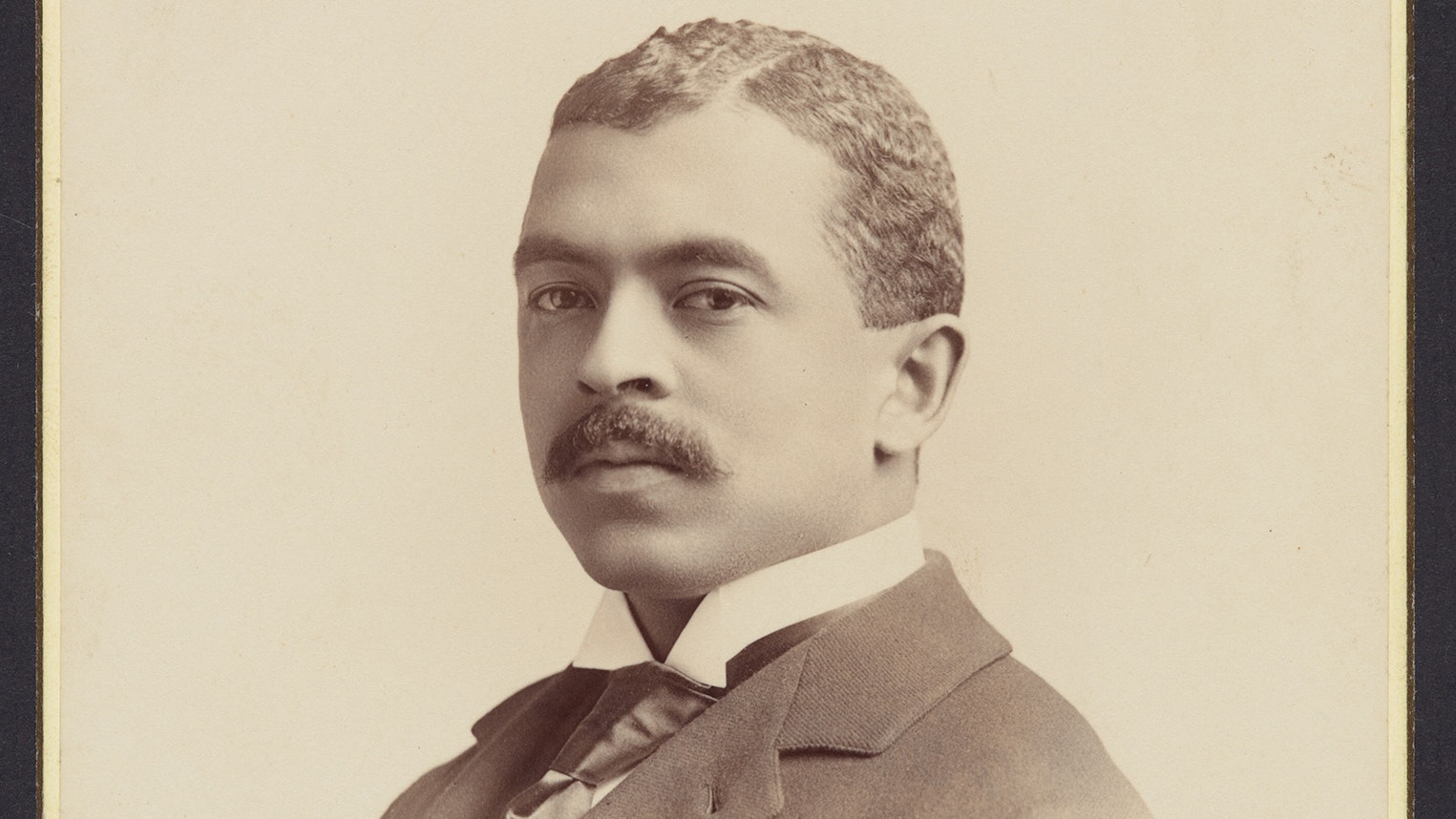
Eliot’s response two days later attempted some clarification of his opinions, which, he noted, were “not newly formed.”Go to footnote 498 detail First, he explained, “The Whites and the Negroes had better live beside each other in entire amity, but separate, under equal laws.” He expressed support for Black suffrage, albeit with a poll tax for all voters, and held that “political equality seems to me to have nothing whatever to do with what is called social equality” and will not lead to “social admixture.”Go to footnote 499 detail He offered his own observations about the South, including his assessment that “it would take four or five generations more to teach the mass of the negro population that civilization is built on willingness to work hard six days in the week, and to be frugal all the time,” partly because it would be “unreasonable to expect that people who had so recently been savages and slaves should all acquire in forty years the primary virtues of civilization.” For good measure, Eliot concluded his letter with the assertion that “as to intermarriage between Whites and Blacks, all the best evidence seems to me to show that it is inexpedient.”Go to footnote 500 detail
When Trotter responded the next day with additional questions about the application of Eliot’s opinions to “actual conditions,” noting that “I believe I am correct in saying the Colored people are quite anxious to know your views,” he received no reply.Go to footnote 501 detail There is likewise no recorded response to Trotter’s second prompt for a reply some five days later.
Eliot’s stature and political savvy set him up to play an active supporting role in the rising eugenics movement in his post-presidency years. He warned that “the increase of liberty for all classes of the community seems to promote the rapid breeding of the defective, irresponsible and vicious” and advocated preventing “the feeble-minded” from “breeding their like.”Go to footnote 502 detail He stopped short of other Harvard affiliates—including his secretary, Frank W. Taussig, who went on to become a faculty member and argued that, although society “[had] not reached the stage where we can proceed to chloroform them once for all,” the “feeble minded” could at least be “segregated, shut up in refuges and asylums, and prevented from propagating their kind.”Go to footnote 503 detail
Charles B. Davenport, William E. Castle, and the International Eugenics Movement
As the eugenics movement took hold in the early 20th century, another Harvard affiliate, Charles B. Davenport (AB 1889; AM 1890; PhD 1892), became one of its key leaders.Go to footnote 504 detail Davenport studied biology at Harvard and stayed on as an instructor until 1899, when he joined the faculty of the University of Chicago. In 1910, Davenport and his fellow eugenics leader Harry H. Laughlin established the Eugenics Record Office in Cold Spring Harbor, New York,Go to footnote 505 detail which became a center for the eugenics movement and produced a wide range of research and propaganda.Go to footnote 506 detail His 1911 book, Heredity in Relation to Eugenics, became the standard text for eugenics courses at colleges and universities across the country and was cited by more than a third of high-school biology textbooks of the era.Go to footnote 507 detail Like his fellow eugenicists, Davenport believed in biological differences among races and the distinctiveness and superiority of the white race, and he virulently opposed race mixing. He advocated for racial restrictions on immigration; “selective elimination” of undesirable people; and acceptance of “the principle of the inequality of generating strains” and “eugenical ideals … in mating,” such that “strains with new and better combinations of traits may arise and our nation take front rank in culture among the nations of ancient and modern times.”Go to footnote 508 detail
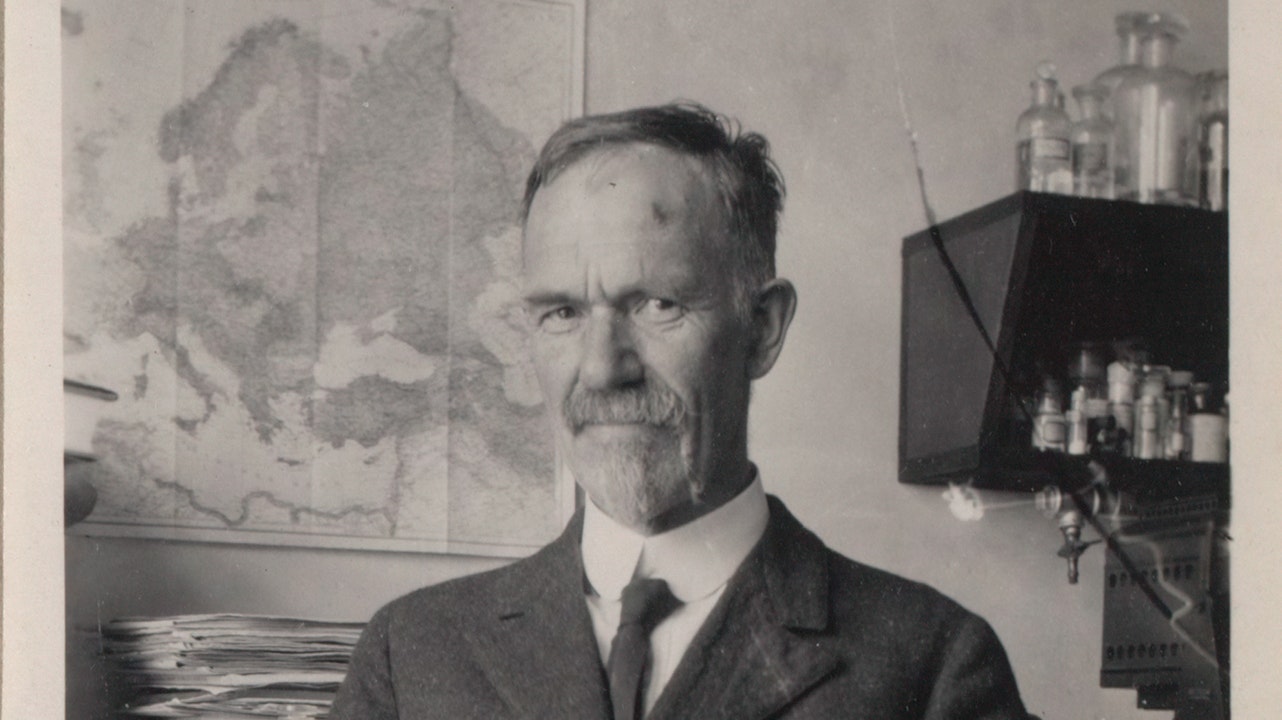
Davenport had a significant impact on his students during his decade as an instructor at the University. Among them was a young William Ernest Castle, who would himself go on to become a major figure in eugenics at Harvard and in the United States.Go to footnote 509 detail Castle enrolled at Harvard College in 1892, pursuing a second bachelor’s degree—he had previously graduated from Denison University—in botany and zoology. Castle worked as a laboratory assistant for Davenport and completed a PhD under the direction of E. L. Mark, the professor of zoology who had also advised Davenport.Go to footnote 510 detail After teaching for two years at the University of Wisconsin and Knox College, Castle returned to Harvard in 1897 as an instructor and researcher in animal breeding, first at the Museum of Comparative Zoology, later at the Bussey Institution, and then the University’s center for agriculture and horticulture.Go to footnote 511 detail
Castle was a prominent member of the American Breeders’ Association (today the American Genetic Association) and a founding member of the editorial board of the journal Genetics.Go to footnote 512 detail In 1912, he was chosen as a member of the American Consultative Committee at the First International Eugenics Congress in London, where Charles William Eliot was then serving as vice president.Go to footnote 513 detail

From 1910 to 1930, Castle taught Genetics and Eugenics, one of several courses on eugenics offered across Harvard at the time.Go to footnote 514 detail He published his lecture notes in 1916 in the textbook Genetics and Eugenics: A Text-book for Students of Biology and a Reference Book for Animal and Plant Breeders,Go to footnote 515 detail which deployed his research into the breeding of animals to advance eugenicist arguments about humans in a concluding chapter titled “The Possibility and Prospects of Breeding a Better Human Race.”Go to footnote 516 detail On race mixing, Castle argued that “from the viewpoint of a superior race there is nothing to be gained by crossing with an inferior race. … From the viewpoint of the inferior race also the cross is undesirable if the two races live side by side, because each race will despise individuals of mixed race and this will lead to endless friction.”Go to footnote 517 detail Moreover, to prevent the inheritance of undesirable traits, Castle concluded that “segregation” of the “feeble-minded” should be implemented in “schools and institutions under state control.” When “segregation is impracticable,” Castle argued, the “feeble-minded … should not be allowed to marry unless first sterilized.”Go to footnote 518 detail
Such ideas, which led to compulsory sterilization practices in approximately 30 states and between 60,000 and 70,000 cases of eugenic sterilization in the United States,Go to footnote 519 detail were also a primary focus of Davenport’s Eugenics Record Office (ERO).Go to footnote 520 detail The ERO quickly gained national and international prominence, and it sustained a dual mission to carry out research and advocate for eugenic research and eugenic policy among the public.Go to footnote 521 detail The organization received funding from the Gladys and Roland Harriman Foundation, the Rockefeller Foundation, and the Carnegie Corporation of New York—a total of $1.2 million between 1910 and 1940Go to footnote 522 detail—and established European connections, particularly with like-minded proponents of eugenics in interwar Germany.
Indeed, the ERO’s Eugenical News introduced German eugenics to an American audience, praised a Nazi sterilization law that drew on ERO research, and became “the main propagandists for the German eugenical cause.”Go to footnote 523 detail As president of the International Federation of Eugenic Organizations, Davenport himself helped restore German eugenicists to a place of prominence in the international movement after World War I.Go to footnote 524 detail At his alma mater, Davenport arranged for a delegation of German eugenicists to participate in Harvard’s 1936 tercentenary celebration.Go to footnote 525 detail
